9 Ways To Connect Your Laptop to a TV Without HDMI Ports

What To Know
- TVs with non-functional HDMI ports can still connect to laptops using various ports such as RF, RCA, S-Video, Component, and DVI.
- Wired solutions involve using HDMI converters or USB-C converters, while wireless options include Built-In Chromecast (Google Cast) and AirPlay.
- Connectivity depends on available ports and features of both the laptop and TV, but there are solutions available for most configurations.
Are you struggling to connect your laptop to your TV without an input HDMI port?
Don’t fret.
In this guide, I will swiftly walk you through alternative methods, both wired and wireless, ensuring you seamlessly enjoy content on your TV from your laptop.
Let’s get started!
Quick Navigation
Depending on your TV’s available ports, you can use one of the adapters/converters below.
| Wired Solutions | Wireless Solutions |
|
|
All of these wired and wireless solutions will allow you to transfer your laptop’s video and audio signals to your TV, so you can watch movies and play games on a big screen without an HDMI port.
Let’s learn more about how to carry out these solutions!
Wired Solutions
While wired solutions require you to invest in an adapter or converter, they are extremely easy to set up. One great thing about them is that you don’t need an internet connection to connect your laptop to your TV. This allows you to watch movies or TV shows downloaded on your laptop on your TV even if your home’s internet is on the fritz!
HDMI Converters
The first way you can connect your laptop to a non-HDMI-compatible TV is by using an HDMI converter. These nifty devices connect to one of your TV’s audio-visual ports and have an HDMI input port to plug your source device into.
Here are the most popular HDMI converters used to connect HDMI-compatible laptops to TVs:
- HDMI to RF Converter
- HDMI to RCA Converter
- HDMI to S-Video Converter
- HDMI to Component Converter
- HDMI to DVI Converter
Lucky for you, we already have a detailed article outlining how to use all of these converters to connect a source device to a non-HDMI-compatible TV. Check out our guide HDMI Adapters For Old TVs: How to Make My TV HDMI Compatible? to learn how to use just about every HDMI converter under the sun!
USB Converter
Many modern laptops do not have HDMI ports but have USB-C ports instead. While these USB ports are not as widespread as HDMI, they are just as useful and can be used to transmit audio and video signals to your TV.
However, it’s important to note that not all USB-C ports can transmit these signals. To see if your computer’s USB-C port supports this function, check that it’s at least USB version 3.1 Gen 2 and supports DP Alt Mode. You can usually find this information in your laptop’s specs list.
Once you’ve verified that your laptop’s USB-C port can transmit these signals, you can use one of these two converters to connect it to your TV.
(Paid Link.)
(Paid Link.)
Let’s learn how!
USB-C to RCA Adapter
RCA ports can be found on many TVs, both modern and old alike. RCA is made up of three ports, two for audio and one for video.
Follow the steps or refer to the diagram below to learn how to connect your USB-C-compatible laptop to a TV using a USB-C to RCA adapter.
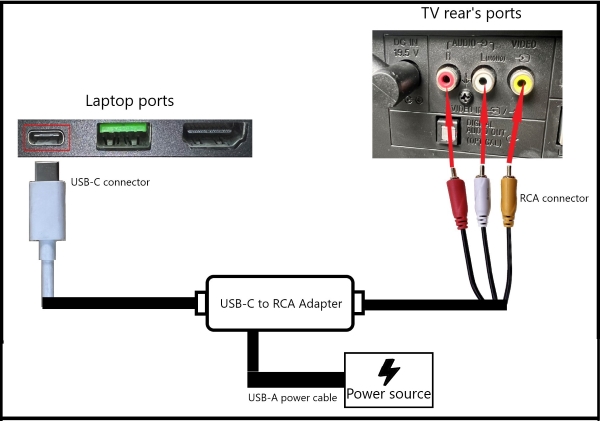
Step 1: Plug the adapter’s USB-C cable into your laptop’s USB-C port.
Step 2: Connect the adapter’s RCA cables to your TV’s RCA ports. Plug the red cable into the red port, the white cable into the white port, and so on. Make sure to use a small amount of pressure to ensure the connector is securely plugged into the port.
Step 3: Plug the adapter into a power source using its USB-A power cable. You can either plug it into a wall outlet or one of your TV’s powered USB ports.
Step 4: Change your TV’s input to RCA.
USB-C to DVI Cable
If your TV doesn’t have an RCA port, it may have a DVI port. However, DVI ports can only carry video signals, meaning you’ll have to play your laptop’s audio through your TV via a separate connection.
Many laptops have an AUX port (e.g. the port you’d normally connect your headphones to), which you can use to play your laptop’s audio from your TV.
Follow the steps or refer to the diagram below to learn how to connect a laptop to a TV using a USB-C to DVI cable.
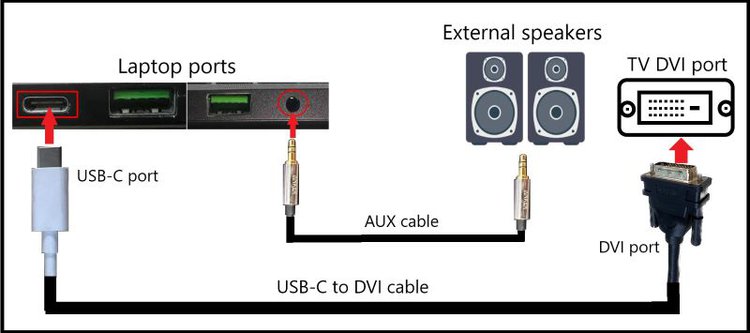
Step 1: Connect the USB-C connector of the USB-C to DVI cable to your laptop’s USB-C port.
Step 2: Connect the DVI connector of the USB-C to DVI cable to your TV’s DVI port. Line the DVI connector up to the port before tightly screwing it in place so it’s flush with the TV.
Step 3: Plug one end of an AUX cable into your laptop’s audio out port (usually marked with a headphone icon).
Step 4: Then, connect the other end of your AUX cable to the audio in port of external speakers.
Step 5: Change your TV’s input to DVI.
Wireless Solutions
Wirelessly connecting your laptop to your TV is a great way to cast and screen mirror content from your laptop without purchasing any new cables or converters. All you need is a compatible smart TV model and an internet connection.
There are two ways you can wirelessly view your laptop on your TV:
- Using Built-In Chromecast (Google Cast)
- Using AirPlay
Chromecast allows you to cast specific tabs or your laptop’s screen and works on any laptop with a Chrome browser. AirPlay only works on iOS devices and MacBooks, and allows you to mirror your device’s entire screen.
Both are equally easy to do and which one is right for you depends on which feature your smart TV and laptop support.
Built-In Chromecast (Google Cast) Feature
Smart TVs with Android TV or Google TV OSes will support the built-in Chromecast (Google Cast) function, allowing you to cast specific videos from your laptop to your TV.
While most laptops should support casting, it’s a good idea to double-check that yours meets Google’s minimum system requirements to cast from Chrome.
Particularly old laptops may not be able to support this function. In this case, you may have to opt for a wired connection instead.
Now that you know your laptop meets the minimum system requirements, you’re ready to start casting.
Make sure your laptop and TV are connected to the same Wi-Fi network before following the steps below to cast your laptop screen to your TV.
Step 1: Open a Chrome browser tab on your laptop.
Step 2: Select the Kebab menu (characterized by three dots) in the upper-right corner of the tab. Go to Cast in the drop-down menu.
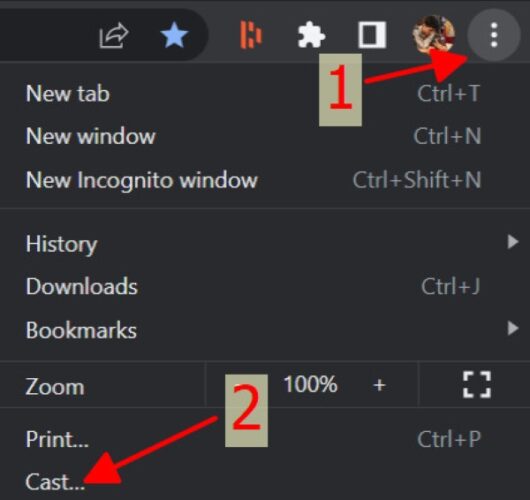
Step 3: Click on the Sources button.
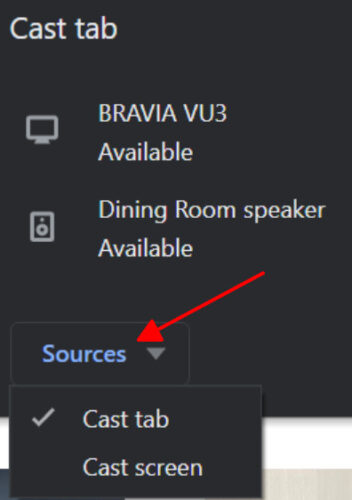
Step 4: You should see two options: Cast tab and Cast screen.
Click on Cast tab if you’d like to only cast the current Chrome tab that’s open to your TV.
Click on Cast screen if you’d like to cast your laptop’s entire screen to your TV.
Step 5: Select your TV name from the device list to start casting content to it.
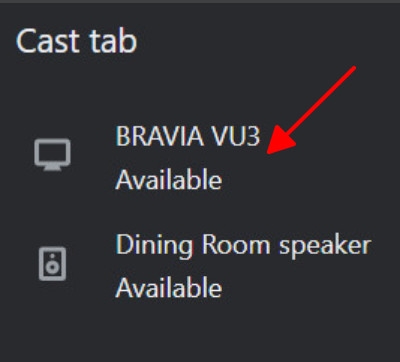
Step 6: Now you should see your laptop’s screen or Chrome tab on your TV!
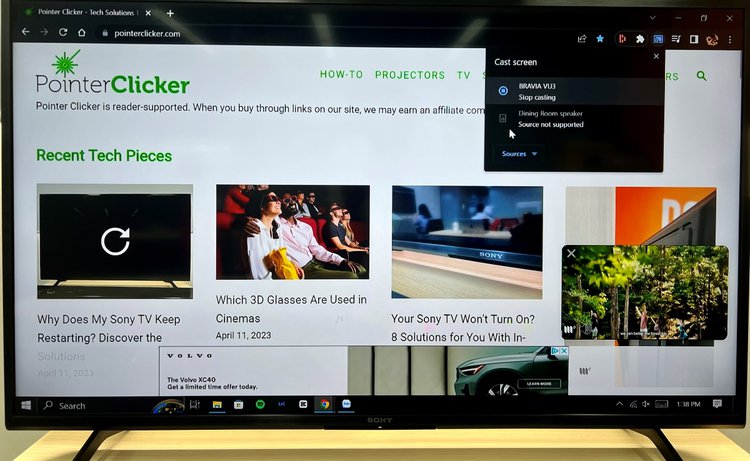
You also have the option to cast specific media files stored on your laptop to your TV by following the steps listed below.
Step 1: Go to your laptop’s file manager, find the file you want to cast, and right-click on the file name.
Step 2: Select Cast to Device from the list of options.
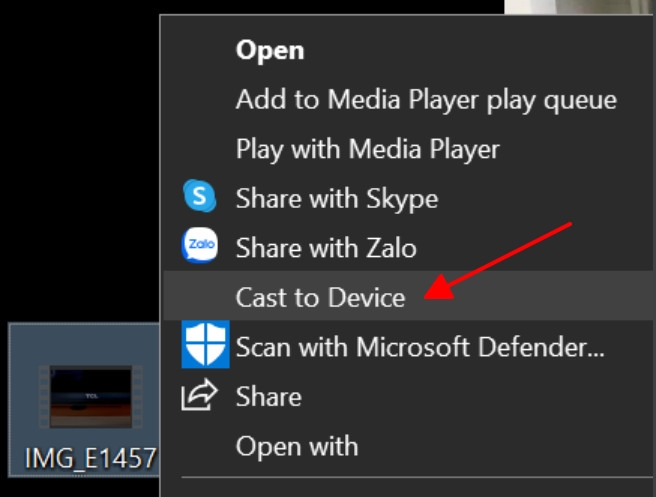
Step 3: If both devices are connected to the same Wi-Fi network, you should see your TV name in the device list. Select it to begin casting.
AirPlay Screen Mirror
If you have a MacBook, you can use its AirPlay function to mirror its screen to your AirPlay-compatible TV. We recommend checking your TV’s user manual or settings to confirm that your TV supports AirPlay.
AirPlay works wirelessly via Wi-Fi, so check that both your MacBook and TV are connected to the same Wi-Fi network before mirroring your MacBook screen to your TV.
This process only takes a couple of seconds and we’ve already created a step-by-step article outlining how to complete it. Read our guide How To Screen Mirror Your MacBook To A Samsung TV? to learn how to connect your MacBook to your TV via AirPlay.
Wrapping Things Up
Your smart TV’s HDMI port may not work anymore, but that doesn’t mean your TV is useless! There are so many ways you can connect your laptop to it using wired and wireless methods.
HDMI converters are the best option if your laptop has an HDMI port. However, if your laptop has a USB-C port, using a USB-C to RCA converter or USB-C to DVI cable is going to be your best bet.
Many smart TVs support built-in Chromecast, especially if they have Android TV or Google TV OSes. This option allows you to cast specific Chrome tabs, your entire laptop screen, or media files.
Apple users can mirror their MacBook’s entire screen using AirPlay if their smart TV supports this feature.
Remember to always check if your laptop and TV are connected to the same Wi-Fi network before trying to cast or screen mirror.
What’s your experience connecting a laptop to a TV without an HDMI port?
Let us know in the comments below!
Yesenia Achlim is a technical copywriter and editor with a focus on AV equipment. She aims to break down complicated topics and make technology accessible, no matter your technical expertise. When she’s not teaching you how to replace a projector lamp, you can find her reading and baking.



